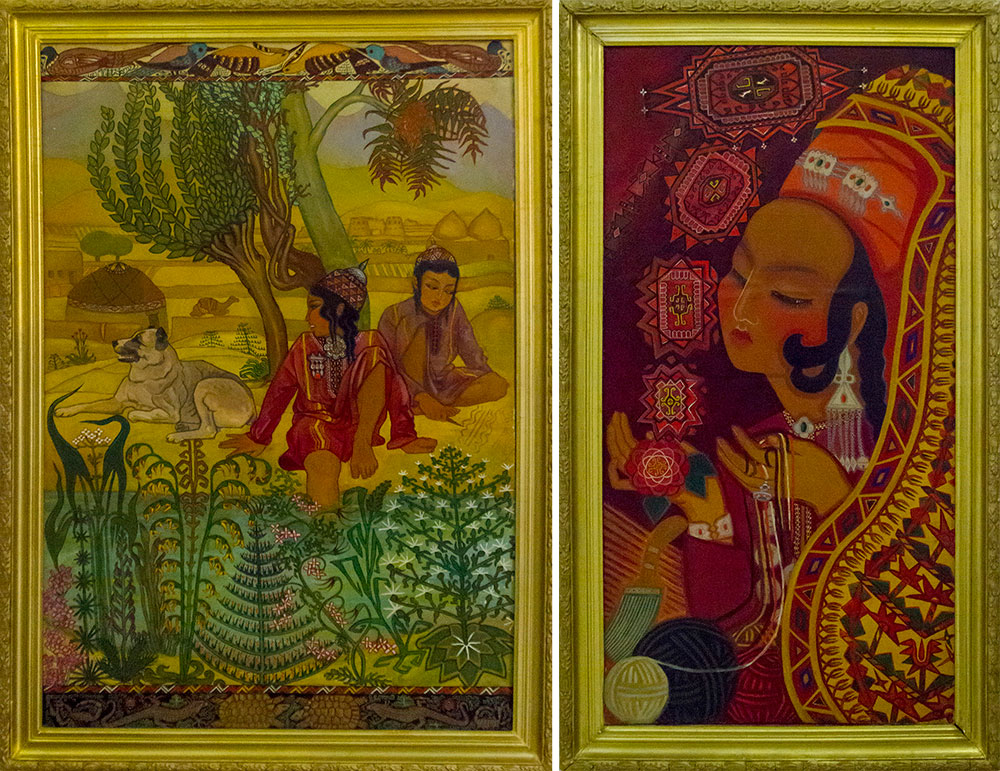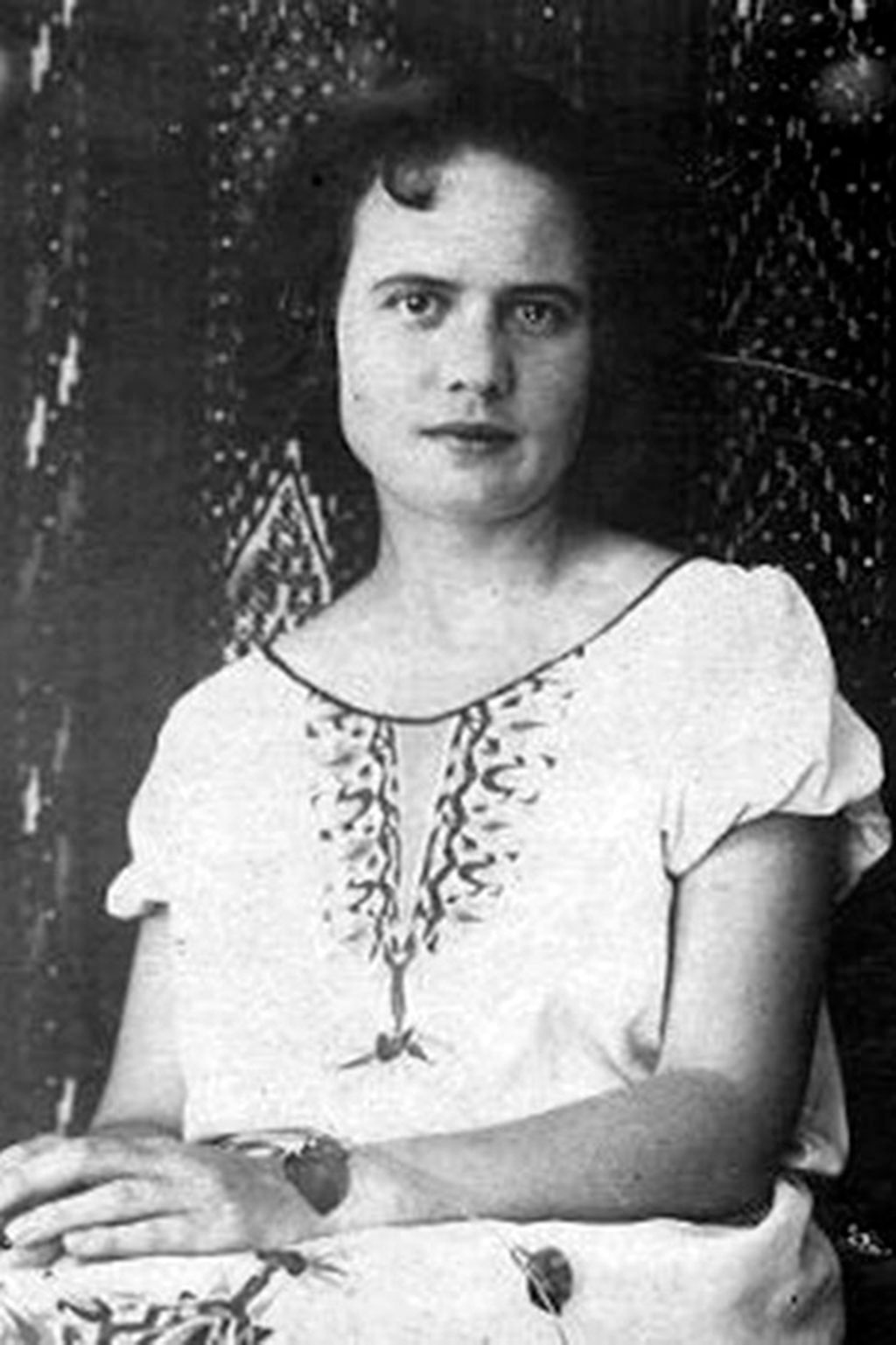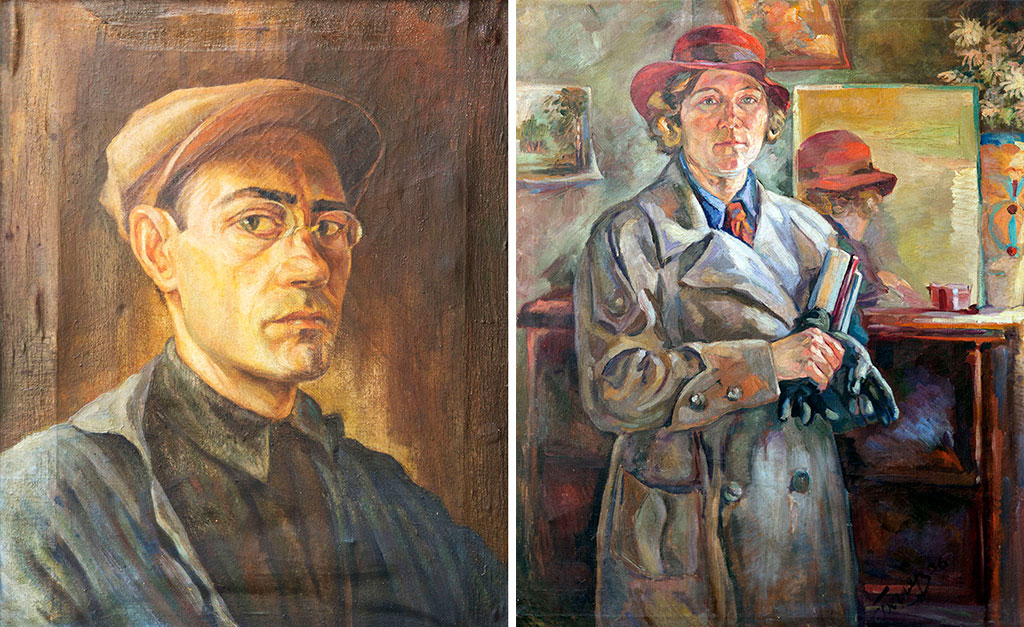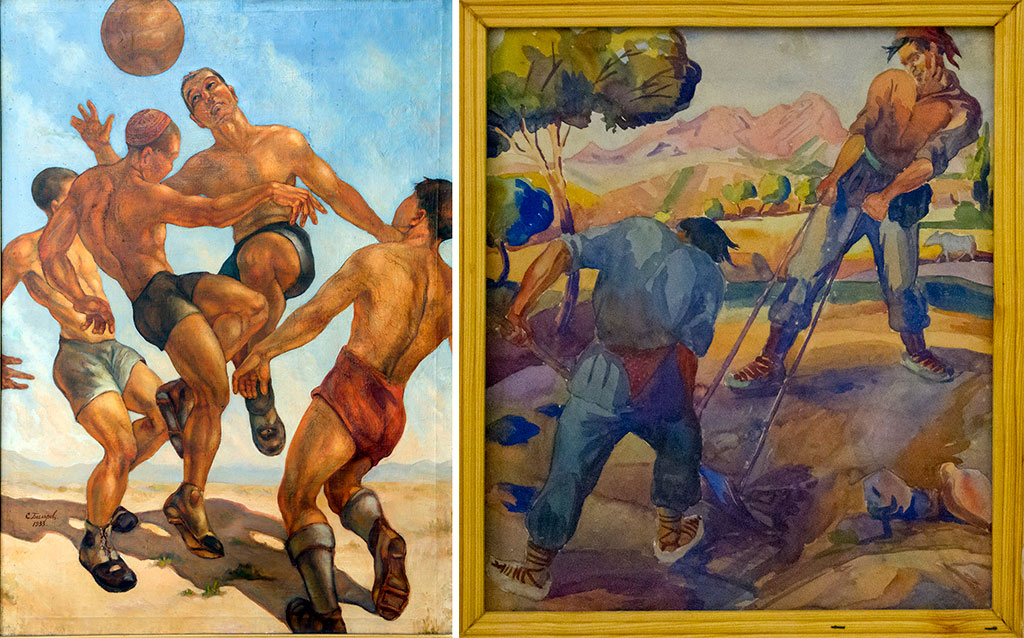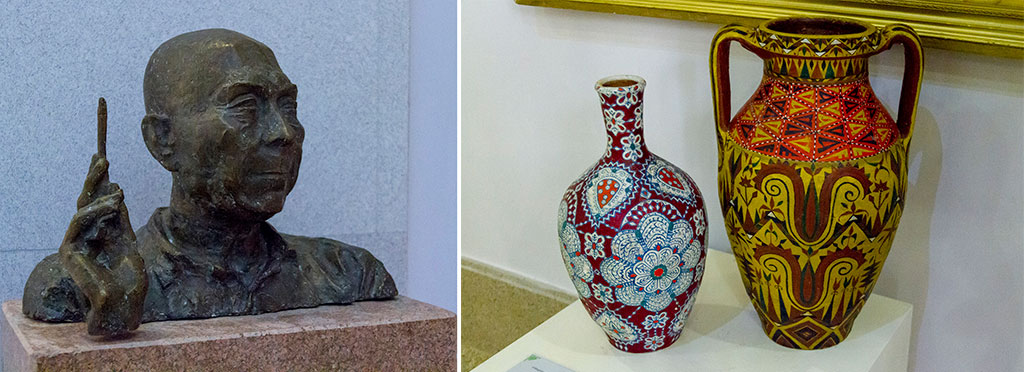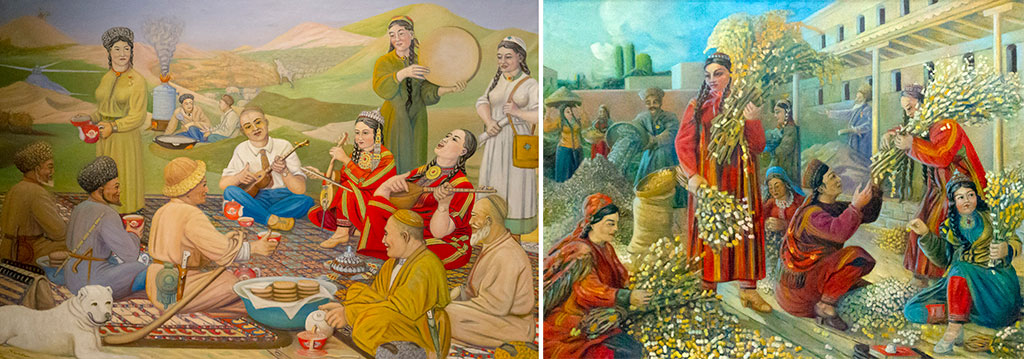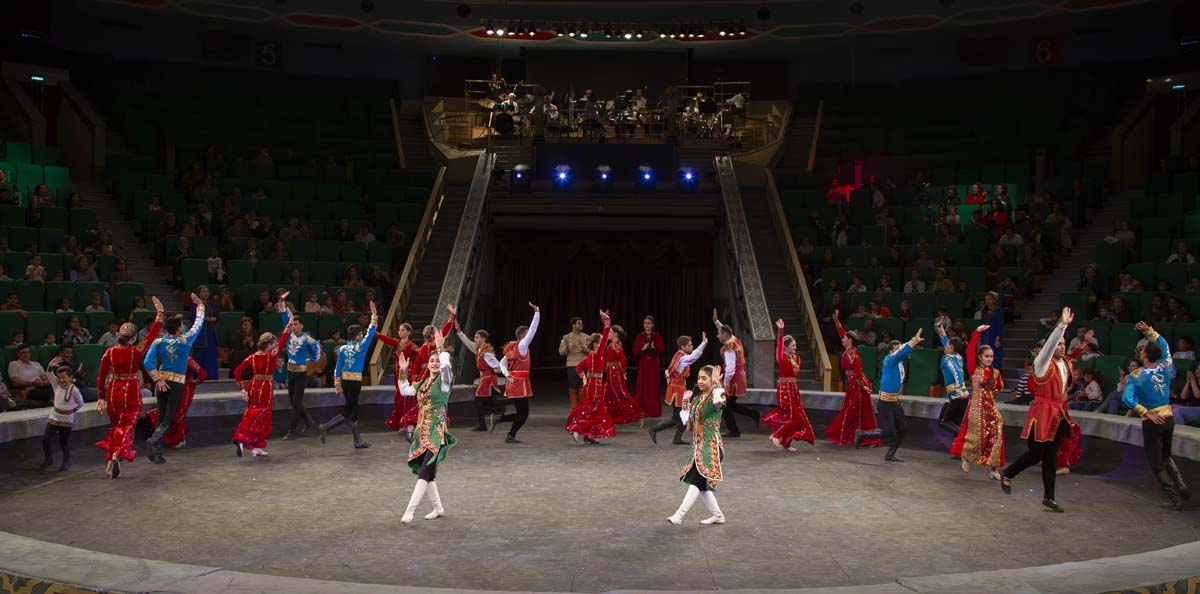The Museum of Fine Arts of Turkmenistan held an exhibition in commemoration of the Shock Movement School of Arts of the East that would have celebrated its centenary this year. The exhibition features documentary records and paintings by art students of the School. Although the Shock Movement School of Arts of the East existed for only six years (1920-1926), it is undisputed that painting in Turkmenistan officially originated from it.
Two enthusiasts Alexander Vladychuk and Ilya (Ruvim) Mazel, who found themselves in Turkmenistan at that difficult time by force of circumstances, co-founded the School. The two pacific and amiable men who studied painting had to put on military uniforms and join the 1st Army of the Turkestan Front when World War I broke out.
Officers Vladychuk and Mazel had received European artistic training and art education, which was characterized by new trends in art in that period. Therefore, avant-garde was welcomed and encouraged during their studies. This was the main reason why the School was closed down afterwards.
The Shock Movement School of Arts of the East, which was in existence for a short period of time, laid the foundation and greatly contributed to the development of Turkmen painting and nurtured the first generation of Turkmen artists. Speaking of the School, special mention must be made of its three most talented students. Back in the past, we told our readers about the lives and careers of Olga Mizgireva, Sergey Beglyarov and Byashim Nurali. Commemorating the School’s centenary, it is only appropriate that we speak of them again.
When teenaged girl Olga Mizgireva, who had a natural bent for drawing, learned about the opening of the School of Arts in Ashgabat, she moved to the capital, without any hesitation, from the settlement of Karakala (presently Magtymguly), where she lived with her parents.
She was really delighted and admired everything at the School: a friendly and welcoming atmosphere among students, professionalism and expertise of teachers, and especially, a school principal. Alexander Vladychuk was truly an extraordinary man in all respects. He was a talented artist, sportsman, inventor and film director. When the Turkmenfilm Studio opened in 1930, he made the first Turkmen documentary film entitled “Reutovka”, then the first feature film “White Gold”, and the first popular science film “Water Wealth of Turkmenia”. In 1935, a group of enthusiasts cycled from Ashgabat to Moscow on wheelcycles (a type of the bicycle invented by Alexander Vladychuk). This all was yet to come later. But at that moment, the young student from Karakala irrevocably fell in love with Alexander Vladychuk and became his wife later.
Ilya Mazel was born in the city of Vitebsk, the birthplace of world renowned avant-garde artists Kazimir Malevich and Marc Chagall. Not only did these three artists come from the same city, they belonged to the same generation. Although obviously influenced by the avant-garde, Mazel worked in many different styles, including the ornamental style.
Works by Olga Fominichna are far from Socialist Realism. Rather ornamental, they exude such a zest for life and good mood that viewers, who are unaware, may think of the artist as their contemporary. The artist’s paintings “The Heat”, “Four Wives”, “Turkmen Girls”, and “The Art of Carpet Making” reveal the beauty of women in the East, their elegance and tenderness. Together with two ceramic vessels painted in the national style, the works are permanently exhibited at the Museum of Fine Arts. Some viewers look slightly confused when they see that the paintings were created in 1926-1927. The fact that Mizgireva was born in 1908, and that the works were painted when she was only 18 or 19, generates even greater interest in the artist herself and her paintings.
Olga Fominichna never shared what had made her turn from paints to seeds. Probably, it was caused by the end of their relationship with Vladychuk. Not only did she break up with him, she also finished her artistic career and moved back to Karakala. A new life began for her, full of discoveries. She completely devoted herself to her new absorbing job as a plant breeder. Since she lacked the special knowledge, Olga Fominichna earned a degree in Agronomy from Agricultural Institute in Ashgabat by completing a distance-learning course.
In 1944, she was appointed director of an experimental breeding station and was in charge of it for 37 years. For her contribution to plant breeding of Turkmenistan, Mizgireva was awarded five gold and two silver medals of the Exhibition of Achievements of the National Economy of the USSR (VDNKh), two Orders of the Red Banner of Labor, two Orders of the Badge of Honor, and earned the title “Honored Agronomist of Turkmenistan”. But her major contribution was Mandrake (Mandragora). She managed to discover this legendary plant in the Kopetdag foothills. Since then, this famed plant, Mandragora Turkmenica, has been listed in Global Plant Inventories.
* * *
Armenian artist Sergey Beglyarov came to fame thanks to the Shock Movement School of Arts of the East. We can only guess how overjoyed the young man was to find out about the opening of the School in Ashgabat that invited anyone wishing to study the basics of painting and visual arts. It was something he had been desperately longing for because he had dreamed of becoming an artist since he was a little boy. In 1919, Sergey Beglyarov took art lessons at a private studio in Baku, but a year later, he and his parents moved to Ashgabat, and this put an end to his artistic training. The tall, thin lad with a pair of round glasses might have experienced a tremendous sense of awe entering the Shock Movement School of Arts, and might have been pleasantly surprised to find himself in a welcoming and positive environment created in the beautiful, big building that brought together young people with different levels of ability.
Technically, Sergey Nikolaevich did not need to study; he was born to be an artist and had his individual style and taste. Ilya Mazel immediately spotted his talent and assigned him to teach drawing. Beglyarov started teaching at the School rather than studying. Later, he became Ilya Mazel’s right-hand man in painting walls in military barracks and offices of regional party committees. The storerooms of the Museum of Fine Arts of Turkmenistan hold some 100 paintings, sketches, and unfinished works by Sergey Beglyarov. In recent years, some art experts have tended to regard Sergey Beglyarov’s creative work as Turkestan avant-garde – an artistic trend that emerged in Central Asia in 1920-1930, to some extent, this opinion was formed due to the fact that Sergey Nikitovich started out on his career as an artist at the Shock Movement School of Arts of the East.
Indeed, the first works by Sergey Beglyarov have elements of contemporary art as he was obviously influenced by the School’s environment. However, Sergey Beglyarov was a realist at heart, and had a realistic view of the world and did not see it in a special way.
One of the artist’s paintings of that time, “Portrait of a Wife”, depicts Elizaveta Skoblina, an alumnus of the Shock Movement School of Arts. The exhibition shows several graphic works by her. Sergey Nikitovich might have worried that he would not be successful as a modern avant-garde artist, since he came to the School as a well-established realist artist. It was good he had not changed his style and ways to conform to the fashion of the day. The School’s closure was a real tragedy for all up-and-coming artists. After that, Sergey Nikitovich went to Armenia to study at Erevan Art College, but he fondly cherished his memories of the Shock Movement School of Arts of the East. After graduating from the college, he returned to his fellow artists in Ashgabat.
In the 1930s, Beglyarov put to good use his remarkable organizational abilities. Like Mazel, Beglyarov made every effort to help former students of the Shock Movement School of Arts. He was one of the initiators of the Association of Artists of Turkmenistan joined by 20 artists, mostly former students of the School. In 1929, the Department of Art was opened at Ashgabat Music College. In 1931, Sergey Nikitovich was appointed to head the department.
Sergey Beglyarov had a proper understanding of the time he lived in. He was a part of the epoch, and reflected the momentous events in his works. In 1939, Sergey Beglyarov was awarded the title “Honored Art Worker of Turkmenistan”.
Sergey Nikitovich was only 50 when he passed away. He had survived the Ashgabat Earthquake, which destroyed the Museum and most of his works were lost. He outlived them by a few months only. However, true artists never die as they live on in controversies among art experts, and their creative work that fills new generations of artists with admiration.
* * *
Byashim Nurali was born at dawn of the 20th century: on January 4, 1900. In winter, he went to Ashgabat astride his donkey to sell milk given by his family’s only cow. And then, everything happened like in a fairytale. Once, a sailor came up to him in the bazar and made a favorable offer: the boy had to bring the milk on the back of his donkey to the Shock Movement School of Arts and the man promised to buy it. Byashim Nurali did not speak Russian, but understood the sailor whom he found very endearing. After loading the cans of milk on the donkey, they made their way towards the strangely named place. It turned out to be a beautiful building with big widows. On entering the building, Byashim Nurali was taken aback. Captured on canvases, there were many scenic views reminiscent of those whose beauty he admired every spring tending flocks of sheep in the Kopetdag foothills. They all were painted. Byashim Nuraly was enormously impressed by the works and soon after he was a student at the School.
After the School was closed down, the most difficult period began in the artist’s life. His former teacher Ilya Mazel helped him to join a preparatory course at the Workers’ Faculty (an institution designed to quickly prepare peasants and workers for higher education) of the Moscow Department of Education to get prepared for the admission to Higher Art and Technical Studios. But Byashim Nurali was not proficient enough in Russian to study theoretical subjects. What is more, his paintings were not fully understood there. His works were criticized for the lack of airiness, spatial perspective, and a sense of proportion when depicting the human body. Somebody else would have given up amid the problems and misunderstanding, but he was not a person who easily gave in to difficulties. He took offence at the critical remarks, argued, but always stood his ground. Byashim Nurali did have his peculiar style of painting, which combined elements of oriental miniature, primitivism and carpet motifs. According to art expert Pavel Popov, every country has painters, who are men of the people, like Byashim Nurali. Creative work by these artists was called “painting of ordinary hearts” in Germany, “Sunday painting” in Switzerland, “primitive art” in America, “the art of people’s painters”. Unfortunately, Byashim Nurali did not know about this and could not bring forward these arguments arguing with his opponents.
In 1930, after Byashim Nurali returned to Ashgabat, he was offered a job as director of the Turkmenfilm Studio. Anything novel was like a magnet for Byashim Yusupovich. When an actor was needed to fill the role of a shepherd in a film called “Sever Hearts”, he exclaimed: “Who can play and handle this role better than a real shepherd?!” And he performed the role, having become one of the first Turkmen actors.
A year later after his return to Ashgabat, he married a carpet weaver, Amansoltan, he was in love with. When watching Amonsoltan at work, an innovative idea came to Byashim Yusupovich again: “Why not to weave a steam locomotive or stone houses that have replaced yurts on a carpet instead of the traditional motifs?” Amansoltan supported her husband, and they began working together making a picture carpet and setting an example to other carpet artists.
Byashim Yusopovich dressed smartly. Most probably, he acquired this habit from Alexander Vladychuk. The Byashim Nurali Children’s Art School in Ashgabat boasts a full-length portrait of the first Turkmen artist dressed stylishly in peg-top trousers and socks. There was something mischievous in his appearance and he used it to the advantage. When he went to Moscow, he put on national clothes - his sheepskin hat and traditional robe (don), on his return home, he wore a tussah silk suit and carried a walking stick. In other words, when in Moscow he dressed in a national style, when at home he wore European-style clothes.
The invention of the handlebar cycle bike by Alexander Vladychuk and the epic handlebar cycle bike journey of the group of sportsmen from Ashgabat to Moscow left a lasting impression on Byashim Nuralievich. He got an idea of creating something new that had not existed before. A few years later, he brought a new musical instrument – a combination of the gijak, the dutar and the tar to the Union of Composers. However, his innovation was not encouraged and promoted.
During the war, Byashim Yusupovich worked as a teacher at the Children’s Art School, which is now named after him. His former student Lyudmila Pavlovna Ulakina told: “Boys found out that after lessons, the teacher put on his Turkmen robe and went to the bazar with a bag of raisins. As if by chance, the boys went past his stall, and the teacher gave each of them a handful of raisins - a real treat in wartime”. This interesting fact characterizes Byashim Yusupovich from two sides: firstly, he was and remained an ordinary man at heart, who had plenty of entrepreneur spirit, despite his fashionable clothes and close contacts with artists; secondly, he was a teacher with a big and kind heart.
In 1947, Byashim Nurali – a man of the people – was awarded the title “Honored Artist of Turkmenistan”. His life was full of dramatic turns and crowing moments: he was a shepherd, an artist, an actor, a teacher and an inventor. He had an insatiable desire for something new and unexplored throughout his entire life. Even Byashim Nurali’s death was entirely accidental – this extraordinary man lost his life in an air crash. He was coming back home from a working trip, when his airplane crashed in the heart of the Karakum Desert, not far from the settlement of Darvaza.
Byashim Nurali is such an interesting and fascinating personality that Turkmen artists often portray him in their paintings, trying to reveal the secret of his magnetism. Aman Jumaev has created one of the best and most successful sculptures of Byashim Nurali. It is installed in front of the Children’s Art School, which carries his name.
* * *
The three artists are closely associated with Alexander Vladychuk and Ilya Mazel as well as with the Shock Movement School of Arts of the East, which did not exist for long, but left an indelible imprint on our country’s art. In fact, it paved the way for the State College of Arts and the State Academy of Arts of Turkmenistan.
Two enthusiasts Alexander Vladychuk and Ilya (Ruvim) Mazel, who found themselves in Turkmenistan at that difficult time by force of circumstances, co-founded the School. The two pacific and amiable men who studied painting had to put on military uniforms and join the 1st Army of the Turkestan Front when World War I broke out.
Officers Vladychuk and Mazel had received European artistic training and art education, which was characterized by new trends in art in that period. Therefore, avant-garde was welcomed and encouraged during their studies. This was the main reason why the School was closed down afterwards.
The Shock Movement School of Arts of the East, which was in existence for a short period of time, laid the foundation and greatly contributed to the development of Turkmen painting and nurtured the first generation of Turkmen artists. Speaking of the School, special mention must be made of its three most talented students. Back in the past, we told our readers about the lives and careers of Olga Mizgireva, Sergey Beglyarov and Byashim Nurali. Commemorating the School’s centenary, it is only appropriate that we speak of them again.
When teenaged girl Olga Mizgireva, who had a natural bent for drawing, learned about the opening of the School of Arts in Ashgabat, she moved to the capital, without any hesitation, from the settlement of Karakala (presently Magtymguly), where she lived with her parents.
She was really delighted and admired everything at the School: a friendly and welcoming atmosphere among students, professionalism and expertise of teachers, and especially, a school principal. Alexander Vladychuk was truly an extraordinary man in all respects. He was a talented artist, sportsman, inventor and film director. When the Turkmenfilm Studio opened in 1930, he made the first Turkmen documentary film entitled “Reutovka”, then the first feature film “White Gold”, and the first popular science film “Water Wealth of Turkmenia”. In 1935, a group of enthusiasts cycled from Ashgabat to Moscow on wheelcycles (a type of the bicycle invented by Alexander Vladychuk). This all was yet to come later. But at that moment, the young student from Karakala irrevocably fell in love with Alexander Vladychuk and became his wife later.
Ilya Mazel was born in the city of Vitebsk, the birthplace of world renowned avant-garde artists Kazimir Malevich and Marc Chagall. Not only did these three artists come from the same city, they belonged to the same generation. Although obviously influenced by the avant-garde, Mazel worked in many different styles, including the ornamental style.
Works by Olga Fominichna are far from Socialist Realism. Rather ornamental, they exude such a zest for life and good mood that viewers, who are unaware, may think of the artist as their contemporary. The artist’s paintings “The Heat”, “Four Wives”, “Turkmen Girls”, and “The Art of Carpet Making” reveal the beauty of women in the East, their elegance and tenderness. Together with two ceramic vessels painted in the national style, the works are permanently exhibited at the Museum of Fine Arts. Some viewers look slightly confused when they see that the paintings were created in 1926-1927. The fact that Mizgireva was born in 1908, and that the works were painted when she was only 18 or 19, generates even greater interest in the artist herself and her paintings.
Olga Fominichna never shared what had made her turn from paints to seeds. Probably, it was caused by the end of their relationship with Vladychuk. Not only did she break up with him, she also finished her artistic career and moved back to Karakala. A new life began for her, full of discoveries. She completely devoted herself to her new absorbing job as a plant breeder. Since she lacked the special knowledge, Olga Fominichna earned a degree in Agronomy from Agricultural Institute in Ashgabat by completing a distance-learning course.
In 1944, she was appointed director of an experimental breeding station and was in charge of it for 37 years. For her contribution to plant breeding of Turkmenistan, Mizgireva was awarded five gold and two silver medals of the Exhibition of Achievements of the National Economy of the USSR (VDNKh), two Orders of the Red Banner of Labor, two Orders of the Badge of Honor, and earned the title “Honored Agronomist of Turkmenistan”. But her major contribution was Mandrake (Mandragora). She managed to discover this legendary plant in the Kopetdag foothills. Since then, this famed plant, Mandragora Turkmenica, has been listed in Global Plant Inventories.
Armenian artist Sergey Beglyarov came to fame thanks to the Shock Movement School of Arts of the East. We can only guess how overjoyed the young man was to find out about the opening of the School in Ashgabat that invited anyone wishing to study the basics of painting and visual arts. It was something he had been desperately longing for because he had dreamed of becoming an artist since he was a little boy. In 1919, Sergey Beglyarov took art lessons at a private studio in Baku, but a year later, he and his parents moved to Ashgabat, and this put an end to his artistic training. The tall, thin lad with a pair of round glasses might have experienced a tremendous sense of awe entering the Shock Movement School of Arts, and might have been pleasantly surprised to find himself in a welcoming and positive environment created in the beautiful, big building that brought together young people with different levels of ability.
Technically, Sergey Nikolaevich did not need to study; he was born to be an artist and had his individual style and taste. Ilya Mazel immediately spotted his talent and assigned him to teach drawing. Beglyarov started teaching at the School rather than studying. Later, he became Ilya Mazel’s right-hand man in painting walls in military barracks and offices of regional party committees. The storerooms of the Museum of Fine Arts of Turkmenistan hold some 100 paintings, sketches, and unfinished works by Sergey Beglyarov. In recent years, some art experts have tended to regard Sergey Beglyarov’s creative work as Turkestan avant-garde – an artistic trend that emerged in Central Asia in 1920-1930, to some extent, this opinion was formed due to the fact that Sergey Nikitovich started out on his career as an artist at the Shock Movement School of Arts of the East.
Indeed, the first works by Sergey Beglyarov have elements of contemporary art as he was obviously influenced by the School’s environment. However, Sergey Beglyarov was a realist at heart, and had a realistic view of the world and did not see it in a special way.
One of the artist’s paintings of that time, “Portrait of a Wife”, depicts Elizaveta Skoblina, an alumnus of the Shock Movement School of Arts. The exhibition shows several graphic works by her. Sergey Nikitovich might have worried that he would not be successful as a modern avant-garde artist, since he came to the School as a well-established realist artist. It was good he had not changed his style and ways to conform to the fashion of the day. The School’s closure was a real tragedy for all up-and-coming artists. After that, Sergey Nikitovich went to Armenia to study at Erevan Art College, but he fondly cherished his memories of the Shock Movement School of Arts of the East. After graduating from the college, he returned to his fellow artists in Ashgabat.
In the 1930s, Beglyarov put to good use his remarkable organizational abilities. Like Mazel, Beglyarov made every effort to help former students of the Shock Movement School of Arts. He was one of the initiators of the Association of Artists of Turkmenistan joined by 20 artists, mostly former students of the School. In 1929, the Department of Art was opened at Ashgabat Music College. In 1931, Sergey Nikitovich was appointed to head the department.
Sergey Beglyarov had a proper understanding of the time he lived in. He was a part of the epoch, and reflected the momentous events in his works. In 1939, Sergey Beglyarov was awarded the title “Honored Art Worker of Turkmenistan”.
Sergey Nikitovich was only 50 when he passed away. He had survived the Ashgabat Earthquake, which destroyed the Museum and most of his works were lost. He outlived them by a few months only. However, true artists never die as they live on in controversies among art experts, and their creative work that fills new generations of artists with admiration.
Byashim Nurali was born at dawn of the 20th century: on January 4, 1900. In winter, he went to Ashgabat astride his donkey to sell milk given by his family’s only cow. And then, everything happened like in a fairytale. Once, a sailor came up to him in the bazar and made a favorable offer: the boy had to bring the milk on the back of his donkey to the Shock Movement School of Arts and the man promised to buy it. Byashim Nurali did not speak Russian, but understood the sailor whom he found very endearing. After loading the cans of milk on the donkey, they made their way towards the strangely named place. It turned out to be a beautiful building with big widows. On entering the building, Byashim Nurali was taken aback. Captured on canvases, there were many scenic views reminiscent of those whose beauty he admired every spring tending flocks of sheep in the Kopetdag foothills. They all were painted. Byashim Nuraly was enormously impressed by the works and soon after he was a student at the School.
After the School was closed down, the most difficult period began in the artist’s life. His former teacher Ilya Mazel helped him to join a preparatory course at the Workers’ Faculty (an institution designed to quickly prepare peasants and workers for higher education) of the Moscow Department of Education to get prepared for the admission to Higher Art and Technical Studios. But Byashim Nurali was not proficient enough in Russian to study theoretical subjects. What is more, his paintings were not fully understood there. His works were criticized for the lack of airiness, spatial perspective, and a sense of proportion when depicting the human body. Somebody else would have given up amid the problems and misunderstanding, but he was not a person who easily gave in to difficulties. He took offence at the critical remarks, argued, but always stood his ground. Byashim Nurali did have his peculiar style of painting, which combined elements of oriental miniature, primitivism and carpet motifs. According to art expert Pavel Popov, every country has painters, who are men of the people, like Byashim Nurali. Creative work by these artists was called “painting of ordinary hearts” in Germany, “Sunday painting” in Switzerland, “primitive art” in America, “the art of people’s painters”. Unfortunately, Byashim Nurali did not know about this and could not bring forward these arguments arguing with his opponents.
In 1930, after Byashim Nurali returned to Ashgabat, he was offered a job as director of the Turkmenfilm Studio. Anything novel was like a magnet for Byashim Yusupovich. When an actor was needed to fill the role of a shepherd in a film called “Sever Hearts”, he exclaimed: “Who can play and handle this role better than a real shepherd?!” And he performed the role, having become one of the first Turkmen actors.
A year later after his return to Ashgabat, he married a carpet weaver, Amansoltan, he was in love with. When watching Amonsoltan at work, an innovative idea came to Byashim Yusupovich again: “Why not to weave a steam locomotive or stone houses that have replaced yurts on a carpet instead of the traditional motifs?” Amansoltan supported her husband, and they began working together making a picture carpet and setting an example to other carpet artists.
Byashim Yusopovich dressed smartly. Most probably, he acquired this habit from Alexander Vladychuk. The Byashim Nurali Children’s Art School in Ashgabat boasts a full-length portrait of the first Turkmen artist dressed stylishly in peg-top trousers and socks. There was something mischievous in his appearance and he used it to the advantage. When he went to Moscow, he put on national clothes - his sheepskin hat and traditional robe (don), on his return home, he wore a tussah silk suit and carried a walking stick. In other words, when in Moscow he dressed in a national style, when at home he wore European-style clothes.
The invention of the handlebar cycle bike by Alexander Vladychuk and the epic handlebar cycle bike journey of the group of sportsmen from Ashgabat to Moscow left a lasting impression on Byashim Nuralievich. He got an idea of creating something new that had not existed before. A few years later, he brought a new musical instrument – a combination of the gijak, the dutar and the tar to the Union of Composers. However, his innovation was not encouraged and promoted.
During the war, Byashim Yusupovich worked as a teacher at the Children’s Art School, which is now named after him. His former student Lyudmila Pavlovna Ulakina told: “Boys found out that after lessons, the teacher put on his Turkmen robe and went to the bazar with a bag of raisins. As if by chance, the boys went past his stall, and the teacher gave each of them a handful of raisins - a real treat in wartime”. This interesting fact characterizes Byashim Yusupovich from two sides: firstly, he was and remained an ordinary man at heart, who had plenty of entrepreneur spirit, despite his fashionable clothes and close contacts with artists; secondly, he was a teacher with a big and kind heart.
In 1947, Byashim Nurali – a man of the people – was awarded the title “Honored Artist of Turkmenistan”. His life was full of dramatic turns and crowing moments: he was a shepherd, an artist, an actor, a teacher and an inventor. He had an insatiable desire for something new and unexplored throughout his entire life. Even Byashim Nurali’s death was entirely accidental – this extraordinary man lost his life in an air crash. He was coming back home from a working trip, when his airplane crashed in the heart of the Karakum Desert, not far from the settlement of Darvaza.
Byashim Nurali is such an interesting and fascinating personality that Turkmen artists often portray him in their paintings, trying to reveal the secret of his magnetism. Aman Jumaev has created one of the best and most successful sculptures of Byashim Nurali. It is installed in front of the Children’s Art School, which carries his name.
The three artists are closely associated with Alexander Vladychuk and Ilya Mazel as well as with the Shock Movement School of Arts of the East, which did not exist for long, but left an indelible imprint on our country’s art. In fact, it paved the way for the State College of Arts and the State Academy of Arts of Turkmenistan.




